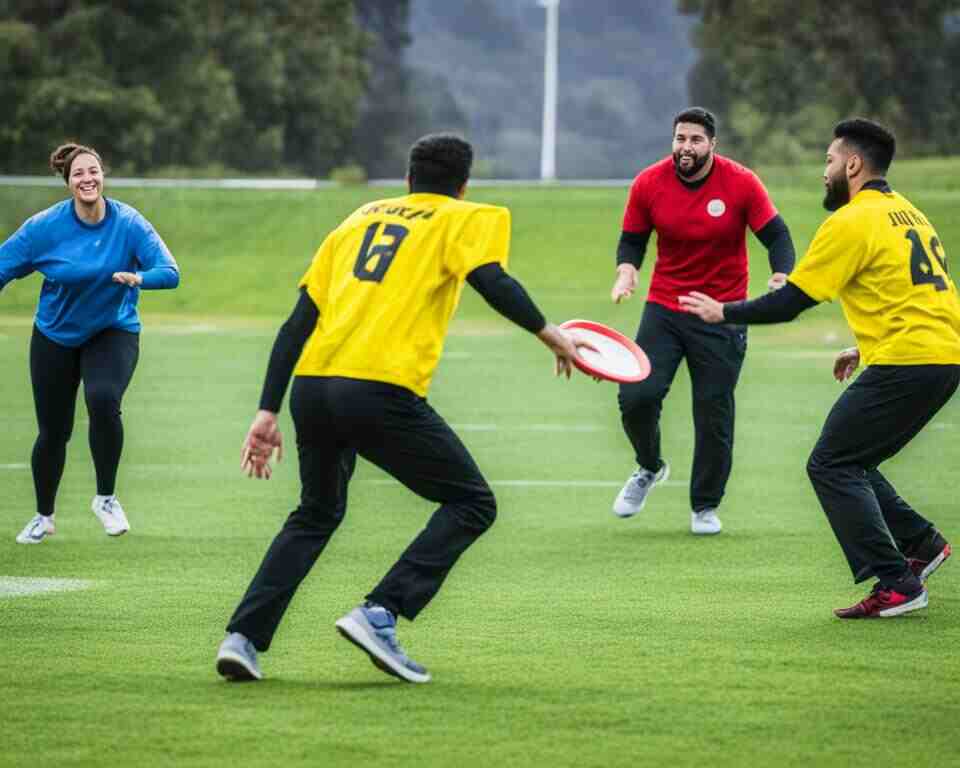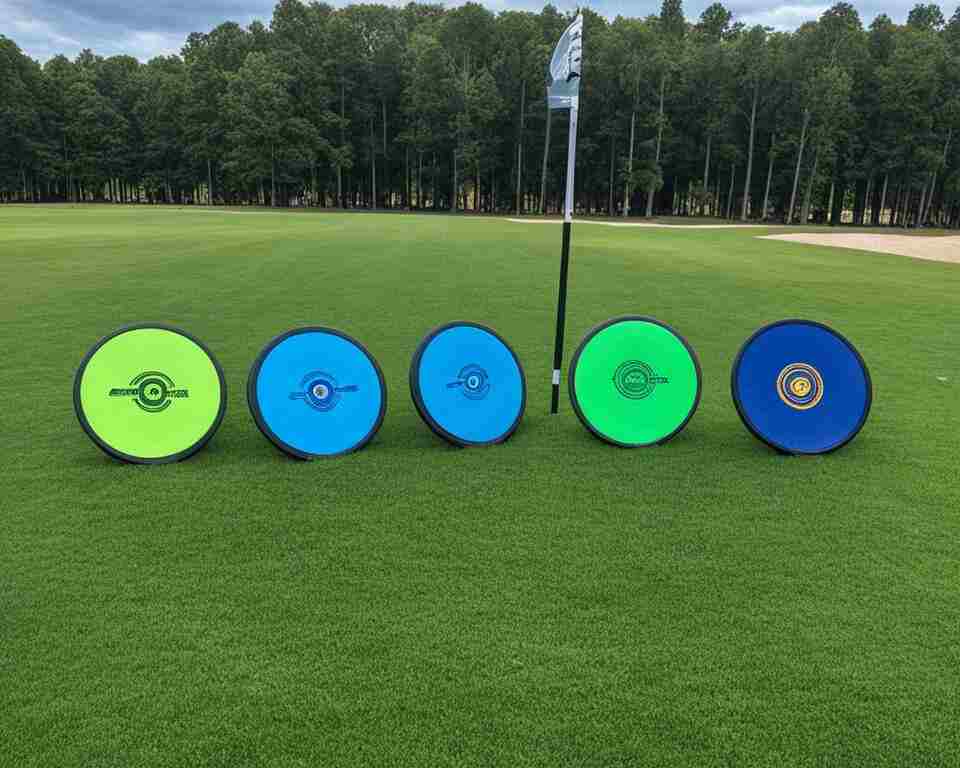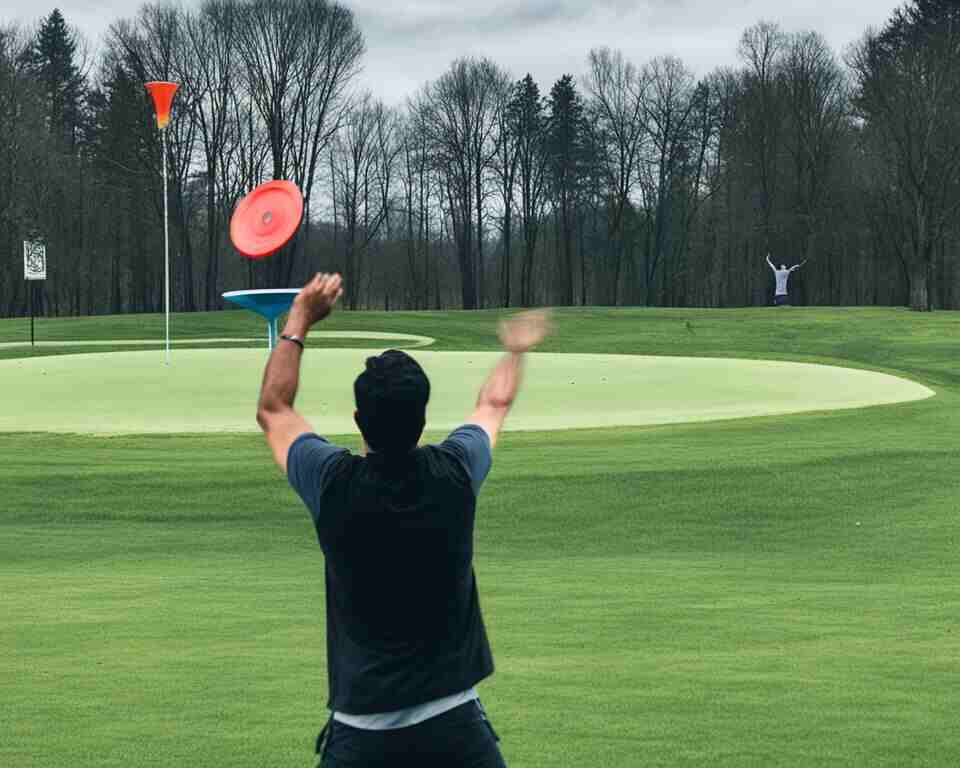In this article, I will provide you with an in-depth comparison of the popular disc sports, disc golf, and ultimate frisbee. Whether you’re a disc golf enthusiast looking to explore ultimate frisbee or an ultimate frisbee player curious about disc golf, this article will highlight the key differences and similarities between the two sports.
By the end of this article, you’ll have a comprehensive understanding of the key aspects of disc golf and ultimate frisbee and be equipped to make an informed decision about which sport suits your preferences and lifestyle. So let’s dive in and discover the exciting world of these disc sports!
Key Takeaways:
- Disc golf and ultimate frisbee are two popular disc sports with distinct differences in scoring, play styles, and playing fields.
- Both sports require specific equipment, including discs, footwear, and gear bags, tailored to the demands of each game.
- Disc golf and ultimate frisbee have vibrant communities and unique cultures that foster inclusivity and a sense of belonging.
- Each sport has its own rules and regulations, upheld by organizations dedicated to promoting fair play and development.
- The physical demands and accessibility of disc golf and ultimate frisbee vary, catering to different fitness levels and physical abilities.

Understanding the Core Differences: Disc Golf vs Ultimate Frisbee
In this section, we will explore the core differences between disc golf and ultimate frisbee. We will discuss how the scoring systems differ, with ultimate frisbee focusing on goals and disc golf utilizing baskets. We will also examine the contrasting play styles, with ultimate frisbee emphasizing teamwork and disc golf presenting individual challenges.
Additionally, we will compare the playing fields of these two sports, with disc golf played on courses with defined boundaries and ultimate frisbee played on dynamic terrains. This section aims to give readers a clear understanding of the fundamental distinctions between disc golf and ultimate frisbee.
Scoring: Goals vs Baskets
In ultimate frisbee, the objective is to score points by throwing the disc into the opposing team’s end zone. Each successful throw that is caught in the end zone results in a goal. On the other hand, disc golf players aim to complete each hole by throwing their disc into a basket. The number of throws it takes to get the disc into the basket represents the score for that hole. While ultimate frisbee focuses on the number of goals, disc golf measures performance based on the number of throws.
Play Style: Teamwork vs Individual Challenges
Ultimate frisbee is a team sport that requires collaboration and effective communication among players. The game revolves around passing the disc to teammates in order to move closer to the opponent’s end zone. Players must work together to strategize and coordinate their movements, emphasizing teamwork and cooperation. On the other hand, disc golf is primarily an individual sport that focuses on individual challenges. Players must navigate the course and make throws on their own, relying on their skills and decision-making abilities to successfully complete each hole.
Playing Fields: Defined Boundaries vs Dynamic Terrain
The playing fields for disc golf and ultimate frisbee also differ significantly. Disc golf courses are designed with defined boundaries, often marked by tee pads and fairways. Players must navigate through trees, shrubs, and other obstacles to reach the baskets. In contrast, ultimate frisbee is played on dynamic terrains such as grass fields, beaches, or indoor arenas. The lack of predefined boundaries in ultimate frisbee allows for more creative play and adaptability to varying environments.
| Aspects | Disc Golf | Ultimate Frisbee |
|---|---|---|
| Scoring | Based on the number of throws into baskets | Based on the number of goals scored |
| Play Style | Individual challenges | Teamwork and collaboration |
| Playing Fields | Courses with defined boundaries | Dynamic terrains without specific boundaries |
Exploring the Equipment: What You Need to Play
Disc Designs: Purpose and Functionality
When it comes to disc golf and ultimate frisbee, having the right equipment is essential for a successful game. Both sports require specialized discs that are designed to meet the specific demands of each game.
In disc golf, there are three main types of discs: drivers, midranges, and putters. Drivers are designed for maximum distance and speed, while midranges offer more control and versatility. Putters are specialized for short, precision shots. Each disc has unique features such as varying flight characteristics, stability levels, and grip textures to cater to different player preferences and playing styles.
In ultimate frisbee, the disc design is focused on aerodynamics, allowing for longer, more accurate throws and catches. The ultimate frisbee disc is typically larger in diameter and thinner compared to disc golf discs. It is engineered to provide better grip and flight stability for quick passes and impressive aerial maneuvers.
Footwear: Cleats vs Trail Shoes
When it comes to footwear, the choice between cleats and trail shoes depends on the sport and playing conditions.
In ultimate frisbee, players often wear cleats, which are specialized shoes with spiked soles. Cleats offer superior traction and stability on grass or turf fields, enabling players to make quick cuts, pivots, and sprints with ease. The spikes grip the ground, preventing slips and falls during intense gameplay.
On the other hand, disc golf is typically played on a variety of terrains, including grass, dirt, and rough terrain. For disc golf, trail shoes are a popular choice. These shoes provide comfort, support, and traction on uneven surfaces. They have durable outsoles with multidirectional lugs and flexible yet sturdy designs, allowing players to navigate through different terrains with confidence.

Gear Bags: Essentials for Each Sport
Carrying gear and accessories is essential for both disc golf and ultimate frisbee players. Gear bags help organize and protect equipment during transport and gameplay.
In disc golf, gear bags are designed to accommodate a selection of discs, often ranging from 10 to 20 discs, along with other essentials such as water bottles, towels, and additional accessories. Disc golf gear bags typically have multiple compartments, padded straps for comfort, and durable construction to withstand outdoor conditions.
For ultimate frisbee players, gear bags are designed to hold multiple discs as well as personal items like clothing, water bottles, and extra accessories. These bags are often lightweight, with convenient storage compartments and comfortable straps for easy carrying during intense games.
By understanding the different disc designs, footwear options, and gear bags associated with disc golf and ultimate frisbee, players can make informed choices that enhance their performance and overall experience in these exciting sports.
The Spirit of the Game: Community and Culture
In both disc golf and ultimate frisbee, the spirit of the game goes beyond the rules and competition. These sports have vibrant communities and unique cultures that foster inclusivity and camaraderie.
Disc golf community: Disc golf enthusiasts form a diverse and passionate community. They come together at tournaments, leagues, and social events to share their love for the game. The disc golf community fosters a sense of belonging, offering support, encouragement, and friendship to players of all skill levels.
Ultimate frisbee community: The ultimate frisbee community is known for its strong bonds and team spirit. Players collaborate and communicate on the field, creating a tight-knit community that extends beyond the game. The ultimate frisbee community promotes fair play, respect, and inclusivity, making it a welcoming space for all.
Disc golf culture: The disc golf culture is deeply intertwined with nature. Players often find themselves immersing in scenic courses, appreciating the beauty of the surroundings. Disc golf culture values sustainability and environmental stewardship, with players actively participating in course maintenance and preservation efforts.
Ultimate frisbee culture: Ultimate frisbee has a culture of positivity and joy. Known for its “Spirit of the Game” philosophy, ultimate frisbee emphasizes fair play, sportsmanship, and self-officiating. The culture encourages players to respect opponents, resolve disputes through open communication, and prioritize the enjoyment of the game.
Rules of the Game: Disc Golf vs Ultimate Frisbee Regulations
In this section, we will explore the rules and regulations of both disc golf and ultimate frisbee. Understanding the rules is essential for players to engage in fair and competitive gameplay. Let’s take a closer look at the rules governing each sport.
Understanding the Rules of Disc Golf
- The player with the lowest score on the previous hole throws first on the next hole.
- Players must complete the entire hole from the tee pad to the target (baskets) using the least number of throws.
- The disc must come to rest within the target (baskets) to be considered successfully completed.
- The first throw from the tee pad establishes the throwing order, with subsequent throws following the order of the farthest from the target.
- Additional rules govern stance, out-of-bounds areas, and penalty strokes for infractions.
Comprehending Ultimate Frisbee Rules
- Teams score points by completing a pass to a teammate in the opposing end zone.
- Players cannot run with the disc; they must throw it to another player within ten seconds.
- Opponents can intercept or knock the disc down to gain possession.
- Players must establish a pivot foot upon catching the disc and can only move that foot while holding the disc.
- The defending team aims to prevent the offense from completing successful passes and scoring points.
Organizations Governing the Sports
Both disc golf and ultimate frisbee have international governing bodies that oversee the sports and promote fair play and development:
| Disc Golf | Ultimate Frisbee |
|---|---|
| Professional Disc Golf Association (PDGA) | World Flying Disc Federation (WFDF) |
| PDGA ensures the rules and standards of disc golf are upheld, organizes tournaments, and ranks players worldwide. | WFDF governs international ultimate frisbee competition, establishes rules and regulations, and promotes the growth of the sport. |
These organizations play a crucial role in maintaining consistency across tournaments and fostering the development of disc golf and ultimate frisbee on a global scale.

Physical Demand and Accessibility: A Comparative Look
When considering which disc sport to participate in, it’s essential to understand the physical demand and accessibility of both disc golf and ultimate frisbee. These factors play a significant role in determining the suitability of each sport for individuals with different fitness levels and physical abilities.
Disc golf, while physically demanding, can be enjoyed by players of varying skill levels. The sport requires a combination of strength, accuracy, and endurance. Players must navigate through courses with different terrains, while strategically throwing discs into baskets. The physical demands of disc golf can provide a great workout and improve cardiovascular fitness.
On the other hand, ultimate frisbee emphasizes speed, agility, and teamwork. With fast-paced gameplay and constant movement, ultimate frisbee can be more physically demanding than disc golf. Players engage in running, jumping, and quick changes of direction, making it an excellent choice for those seeking a high-intensity workout.
Accessibility is another crucial aspect to consider when choosing a disc sport. Disc golf typically offers a higher level of accessibility, as it can be played on various types of courses, from sprawling professional courses to smaller community-based ones. This accessibility allows players to find courses that are suitable for their skill levels and physical abilities.
While ultimate frisbee may require more space and specific field conditions, such as marked boundaries and goal zones, it still offers opportunities for players to engage in smaller-scale matches in parks or recreational areas. Ultimate frisbee leagues and pickup games can be found in many communities, providing accessible options for players of all skill levels.
Comparative Overview of Physical Demand and Accessibility
| Physical Demand | Accessibility | |
|---|---|---|
| Disc Golf | Requires strength, accuracy, and endurance Provides a good cardiovascular workout | Accessible to players of different skill levels Various course options available |
| Ultimate Frisbee | Emphasizes speed, agility, and teamwork Offers a high-intensity workout | Accessible through leagues and pickup games Requires specific field conditions |
Overall, both disc golf and ultimate frisbee offer unique physical challenges and accessibility options. Disc golf provides a more versatile range of course options, while ultimate frisbee’s fast-paced gameplay demands agility and coordination. Whether you prefer the strategic approach of disc golf or the dynamic team dynamics of ultimate frisbee, both sports provide opportunities for physical fitness and enjoyment.
The Staple Discs of Each Sport: Models and Choices
When it comes to disc golf and ultimate frisbee, having the right discs is essential for success on the course. In this section, we will explore the staple discs used in both sports, highlighting their specific functions and characteristics.
Disc Golf Drivers, Midranges, and Putters
In disc golf, players rely on a variety of discs to navigate the course. Disc golf discs are specifically designed to maximize distance, accuracy, and control. There are three main types of discs used in disc golf: drivers, midranges, and putters.
Disc Golf Drivers: Drivers are designed for maximum distance. They have a sharp edge, convex profile, and are typically heavier than other disc types. Drivers are ideal for long throws off the tee and navigating long fairways.
Disc Golf Midranges: Midranges offer a balance between distance and control. They have a slightly smaller profile than drivers and a slightly thicker edge. Midranges are versatile discs that can be used for accurate approach shots and controlled long throws.
Disc Golf Putters: Putters are designed for precision and accuracy. They have a blunt edge and a shallow rim. Putters are used for short-range shots, including putting into the basket. They offer excellent control and touch around the green.
The Recognizable Ultimate Frisbee Disc
In ultimate frisbee, the disc used is a standard frisbee that most people are familiar with. The official disc used in ultimate frisbee is a 175-gram disc with a diameter of 10.75 inches. It is designed for stability, durability, and ease of catching and throwing. The ultimate frisbee disc has a smooth, rounded edge and a flat profile, allowing players to execute a variety of throws and catches with precision.
In conclusion, disc golf and ultimate frisbee both require specific discs that cater to the demands of each sport. Whether it’s the different types of discs used in disc golf or the recognizable frisbee disc used in ultimate frisbee, having the right discs can greatly enhance your gameplay. By understanding the functions and characteristics of these staple discs, you’ll be well-equipped to excel in both sports.
Strategies and Techniques: Mastering the Disc
In the game of disc sports, mastering the disc requires a combination of skill, technique, and strategic thinking. Whether you’re playing disc golf or ultimate frisbee, understanding the right techniques and strategies can give you a competitive edge. In this section, I will discuss the key strategies and techniques used in both disc golf and ultimate frisbee, helping you improve your game and achieve success on the field.
Disc Golf Throwing Techniques and Tips
When it comes to disc golf, the success of your throws heavily relies on proper technique. Here are a few throwing techniques and tips to help you improve your disc golf game:
- Backhand throw: This is the most common throwing technique in disc golf. Grip the disc firmly with your dominant hand and bring it across your body, releasing it with a slight twist of the wrist to generate spin.
- Forehand throw: Also known as a sidearm throw, the forehand technique involves gripping the disc with your fingers on the top and your thumb on the bottom. Snap your wrist forward, releasing the disc with a flick of the wrist.
- Putting technique: When it comes to putting, focus on a smooth, controlled throw. Keep your wrist straight and generate power from your legs and core. Practice your putting technique regularly to improve accuracy and consistency.
- Practice and repetition: Consistent practice is essential for improving your disc golf throws. Find an open field or a disc golf course to practice different throwing techniques and experiment with different disc types to find what works best for you.
Team Strategies for Ultimate Success
In ultimate frisbee, teamwork and strategic play are crucial for achieving success. Here are some key team strategies to consider:
- Vertical stack: This offensive strategy involves players positioning themselves in a vertical line down the field. It allows for effective cutting and throwing opportunities.
- Horizontal stack: In this strategy, players align themselves horizontally across the field, creating space for cutting and clearing.
- Zone defense: Zone defense is commonly used in ultimate frisbee to slow down the opposing team’s offense. Players work together to create a defensive wall, preventing easy passes and forcing turnovers.
- Communication: Effective communication is key to successful teamwork in ultimate frisbee. Constantly communicate with your teammates, both on offense and defense, to coordinate plays, mark opponents, and create scoring opportunities.
- Adaptability: Ultimate frisbee is known for its fast-paced and dynamic nature. Be adaptable and flexible in your strategies, adjusting to different game situations and opponents’ defenses.
Remember, mastering the disc in both disc golf and ultimate frisbee takes time, practice, and a willingness to learn. Continuously refine your techniques, experiment with different strategies, and embrace the collaborative nature of team sports.
Finding a Place to Play: Courses and Leagues
When it comes to disc golf and ultimate frisbee, finding suitable places to play is essential for enthusiasts and newcomers alike. Whether you’re looking to explore disc golf courses or join ultimate frisbee leagues, this section will provide you with the necessary information to get started.
Disc Golf Courses:
Disc golf courses are specifically designed for players to test their skills and enjoy the beauty of the outdoors. To find disc golf courses near you, I recommend using online resources and apps that provide comprehensive maps and directories. These platforms offer valuable information about course locations, difficulty levels, and user reviews, helping you make informed decisions about where to play. By exploring local disc golf courses, you can discover challenging fairways, unique landscapes, and a community of players passionate about the sport.

If ultimate frisbee is more your style, joining a league or participating in tournaments is an exciting way to engage with the sport and connect with fellow players. Start by researching local ultimate frisbee leagues and organizations in your area. These leagues typically offer various divisions for players of all skill levels, ensuring a competitive and inclusive experience. Moreover, ultimate frisbee tournaments bring together teams from different regions, allowing players to showcase their abilities and form lasting connections.
By immersing yourself in disc golf courses and ultimate frisbee leagues, you can develop your skills, foster friendships, and experience the unique thrill of these disc sports.
| Disc Golf Courses | Ultimate Frisbee Leagues |
|---|---|
| Use online resources and apps to find local disc golf courses | Research local ultimate frisbee leagues and organizations in your area |
| Explore course locations, difficulty levels, and user reviews | Join leagues with divisions suited to your skill level |
| Discover challenging fairways and unique landscapes | Participate in tournaments to showcase your abilities |
| Connect with a community of passionate disc golfers | Form lasting connections with fellow ultimate frisbee players |
The Evolution of Disc Sports: A Historical Perspective
In this section, we will take a historical perspective on the evolution of disc sports. We will explore the birth and global reach of ultimate frisbee, tracing its origins and growth into the popular sport it is today. Additionally, we will delve into the pioneers of disc golf and their significant contributions to the development of the sport and the establishment of disc golf courses.
The Birth of Ultimate Frisbee and Its Global Reach
Ultimate frisbee, also known simply as ultimate, was born in the late 1960s on the campuses of American universities. The sport was initially played with a Frisbee disc and combined elements of American football and soccer. The casual and inclusive nature of ultimate frisbee quickly gained popularity among college students and spread to other parts of the world.
Today, ultimate frisbee is played internationally, with competitive leagues, tournaments, and even professional teams. The sport has earned global recognition and has become a staple in the world of disc sports, captivating players and fans alike with its fast-paced action and spirit of sportsmanship.
The Pioneers of Disc Golf and Course Development
Disc golf, a variation of traditional golf played with flying discs or frisbees, experienced its own evolution over the years. The sport traces its roots to the 1970s when early players began experimenting with disc throwing techniques on traditional golf courses. These pioneers recognized the unique potential of disc golf and played a crucial role in developing and defining the sport.
Since then, disc golf course development has continued to flourish worldwide, with dedicated courses designed specifically for the sport. Today, disc golf courses are found in parks, nature reserves, and specialized disc golf facilities, providing players with challenging and scenic environments to enjoy the game.
| Pioneers of Disc Golf | Courses Developed |
|---|---|
| “Steady” Ed Headrick | DeLaveaga Disc Golf Course (California, USA) |
| Tom Schot | La Mirada Disc Golf Course (California, USA) |
| John Ahart | Beaver State Fling Course (Oregon, USA) |
These pioneers and many others played integral roles in shaping the sport of disc golf and transforming it into the thriving community it is today. Their contributions have paved the way for enthusiasts to enjoy the challenges and camaraderie of disc golf around the world.
Conclusion
In conclusion, both disc golf and ultimate frisbee offer unique experiences and opportunities for players of all skill levels. When choosing between these two disc sports, it is important to consider personal preferences and lifestyle factors. Disc golf, with its peaceful courses and individual challenges, may appeal to those who enjoy a more relaxed and solitary experience. On the other hand, ultimate frisbee offers a dynamic team-oriented game that fosters camaraderie and strategic collaboration.
If you are interested in getting started in disc sports, there are several steps you can take. To begin, familiarize yourself with the rules and regulations of the chosen sport. Seek out local disc golf courses or ultimate frisbee leagues to join, as these communities can provide valuable guidance and support. Additionally, invest in the necessary equipment, such as discs and appropriate footwear, to enhance your playing experience.
Disc sports offer a unique way of life that can bring numerous benefits to individuals and communities alike. Beyond the physical fitness aspect, these sports promote social interaction, mental well-being, and a sense of belonging. Engaging in disc golf or ultimate frisbee can provide a break from the daily grind, a chance to reconnect with nature, and a platform for personal growth. Whether you choose disc golf or ultimate frisbee, embrace the spirit of the game and enjoy the many rewards these sports have to offer.


